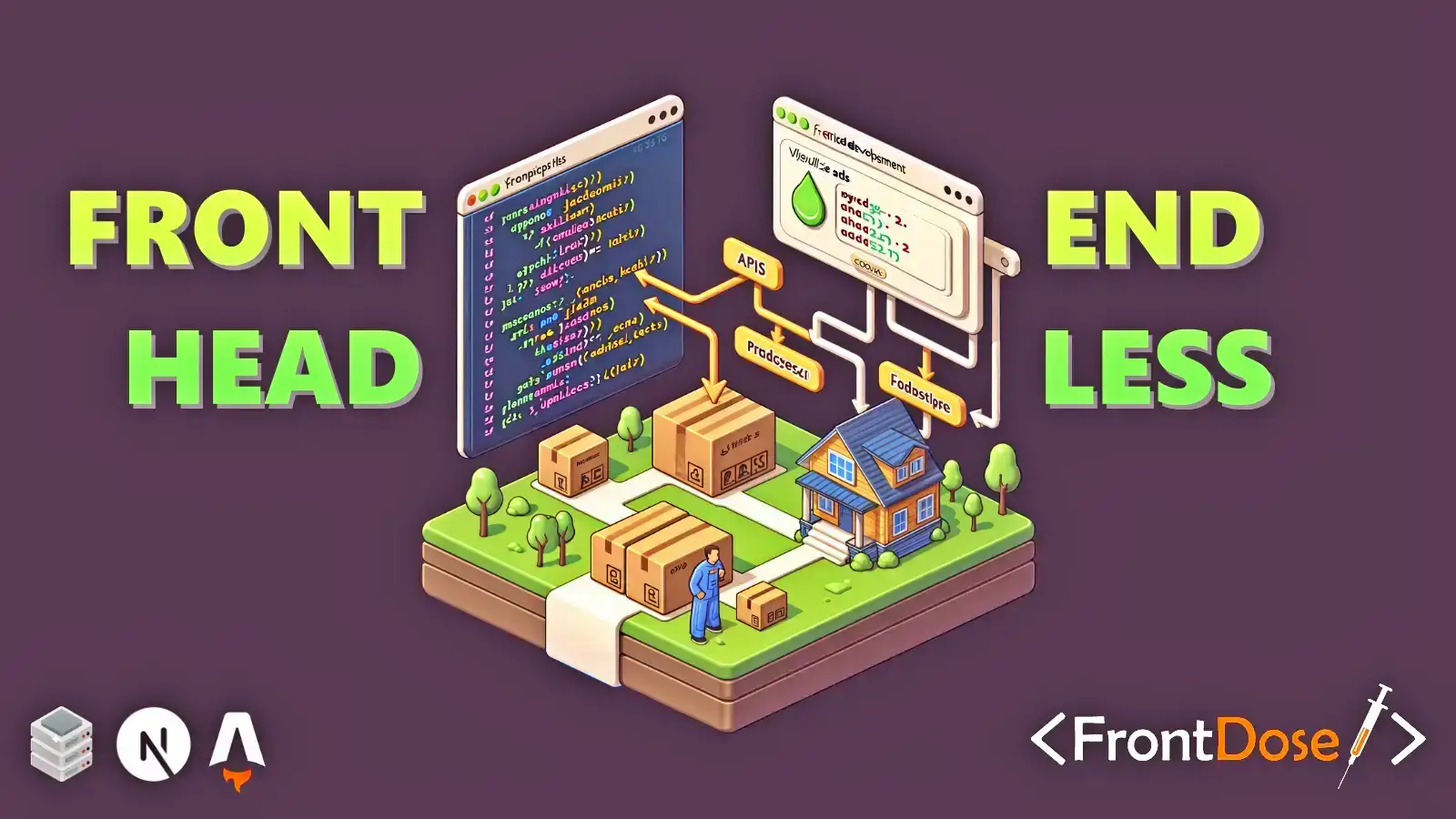Web development is undergoing a paradigm shift with the rise of headless technology and modern frameworks like Next.js and Astro. Traditional CMS platforms like WordPress, which combine content management and presentation, are being replaced by headless CMS solutions that decouple the backend from the frontend. This shift has fundamentally redefined the responsibilities of frontend developers, giving them more freedom, but also increasing the complexity of their roles.
In this article, we’ll explore how headless technology is changing the landscape of web development, and how frameworks like Next.js, Astro, and emerging AI-assisted tools are empowering frontend developers to build faster, more flexible, and more scalable web applications.
What is Headless Technology and Why Does It Matter?
At its core, headless architecture separates the content layer (backend) from the presentation layer (frontend). A headless CMS acts as a content repository that delivers data via APIs (REST or GraphQL), while the frontend handles how the data is displayed. Unlike traditional CMS solutions, where the backend and frontend are tightly coupled, headless technology provides developers with the freedom to build custom frontends tailored to any platform—web, mobile, or even IoT devices.
This decoupled structure offers numerous benefits:
- Flexibility: Content can be reused across multiple platforms.
- Performance: Developers can optimize the frontend for speed and SEO without being constrained by backend templates.
- Scalability: A headless CMS can easily handle large-scale projects with dynamic data requirements.
- AI-Enhanced Content Delivery: Many modern headless CMS platforms (like Contentful, Sanity, and Strapi) now integrate AI-assisted content modeling and automated schema generation, allowing faster data structuring and improved personalization.
Frameworks Leading the Headless Revolution: Next.js and Astro
With the rise of headless CMS, frontend frameworks have become essential tools for developers. Two frameworks that stand out in this space are Next.js and Astro, each offering unique benefits for building high-performance applications.
Next.js 15: The Powerhouse for Dynamic Frontends
Next.js, built on React, remains a powerhouse framework — and as of version 15, it introduces Partial Prerendering (PPR) and AI-assisted optimizations for faster build times and better caching.
Its core features now include:
- Static Site Generation (SSG): Generates static pages at build time for fast loading and enhanced SEO.
- Server-Side Rendering (SSR): Renders pages on the server for dynamic content and improved SEO.
- Incremental Static Regeneration (ISR): Updates static pages incrementally without requiring a full rebuild.
- Partial Prerendering (PPR): Combines static and dynamic rendering on the same page for optimal performance.
- Edge Functions & AI Routing: Uses AI models to predict routing and cache preloading for user intent.
Next.js is ideal for projects with complex content structures, such as eCommerce sites, blogs, and SaaS platforms.
Astro 4: Optimized for Performance and Intelligence
Astro continues to push the boundaries of static and hybrid site generation. Astro 4, released in late 2025, introduces native support for islands-based SSR and AI-driven image optimization.
Its “islands architecture” ensures that only the necessary JavaScript is loaded for each page, making it perfect for static websites and projects where speed is critical.
New in 2025:
- View Transitions API integration
- Composable components with design systems
- AI-powered content prefetching
Astro excels in content-rich blogs, marketing sites, and documentation platforms where performance and maintainability are top priorities.
How the Role of the Frontend Developer is Evolving
The adoption of headless technology and modern frameworks has shifted many responsibilities from the backend to the frontend. As a result, the frontend developer’s role has become more central to the development process, blending traditional frontend tasks with backend-like responsibilities — and now, with AI and automation in the mix.
1. Independence from the Backend
With headless architecture, the frontend is no longer tied to the backend’s templates or rendering logic. Frontend developers have complete control over the UI and can build custom interfaces using their preferred frameworks and tools.
What this means:
Frontend developers now take full ownership of how content is displayed, creating unique, platform-agnostic experiences.
2. Data Management via APIs
In a headless setup, content is delivered through APIs (REST or GraphQL). Frontend developers are responsible for:
- Writing queries to fetch data.
- Handling errors and managing the state of incoming data.
- Optimizing API calls to avoid over-fetching or under-fetching data.
- Using AI query optimizers (like Sanity AI Assist) to generate queries and caching strategies.
What this means:
Frontend developers need a deeper understanding of API structures and can now rely on AI tools to accelerate and validate integrations.
3. Building Dynamic, Modular, and Composable UIs
Headless technology requires frontend developers to build the entire UI from scratch. In 2025, this approach is further strengthened by composable architecture — combining multiple headless services (CMS, search, payments, analytics) into modular, reusable blocks.
Developers must:
- Create reusable UI components aligned with design systems like Figma Tokens or Storybook.
- Use component-driven content modeling for consistency.
- Leverage AI code suggestions to accelerate UI development.
What this means:
Frontend development now merges creativity with system thinking — combining design, architecture, and automation.
4. Optimizing Performance, SEO, and Accessibility
Performance and SEO remain critical in modern web applications. Frameworks like Next.js and Astro provide tools to address these needs. As of 2025, AI now assists with real-time performance audits, Lighthouse optimization, and accessibility improvements.
Frontend developers must:
- Choose the right rendering method (SSG, SSR, ISR, or PPR).
- Optimize site performance using lazy loading, caching, and edge rendering.
- Ensure accessibility compliance (WCAG 2.2+).
- Integrate AI performance analyzers for automated suggestions.
5. Adopting TypeScript and AI-Powered Testing
As data structures become more complex, TypeScript remains essential — but now it’s complemented by AI testing tools like Codeium and GitHub Copilot Test, which automatically generate type-safe unit tests.
What this means:
Frontend developers can maintain stability and reliability while reducing manual testing overhead.
6. Collaboration with Backend and AI Systems
Collaboration now extends beyond human teams. Many organizations use AI middleware to manage APIs, monitor latency, and detect schema mismatches automatically.
What this means:
Frontend developers collaborate not only with backend developers but also with AI-powered systems that ensure stability, scalability, and performance.
The Future of Frontend Development with Headless and AI
The rise of headless CMS and frameworks like Next.js and Astro — now combined with AI-driven workflows — marks a new era in web development.
Frontend developers are at the intersection of creativity, data, and automation, responsible for:
- Fetching, managing, and rendering data intelligently.
- Building high-performance, SEO-friendly, accessible interfaces.
- Creating composable, reusable, and AI-optimized components that scale across platforms.
This evolution not only increases the responsibilities of frontend developers but also provides greater creative freedom and smarter tooling.
Conclusion
Headless technology, now infused with AI and composable architecture, is transforming how web applications are built.
Frameworks like Next.js 15 and Astro 4 empower developers to create faster, smarter, and more scalable digital experiences — redefining the very essence of frontend development.
The role of the frontend developer has never been more dynamic, creative, or impactful.
As we step deeper into 2025, embracing headless and AI-powered workflows isn’t just an advantage — it’s the new standard for modern web development.
Code with passion. Create with intelligence.

